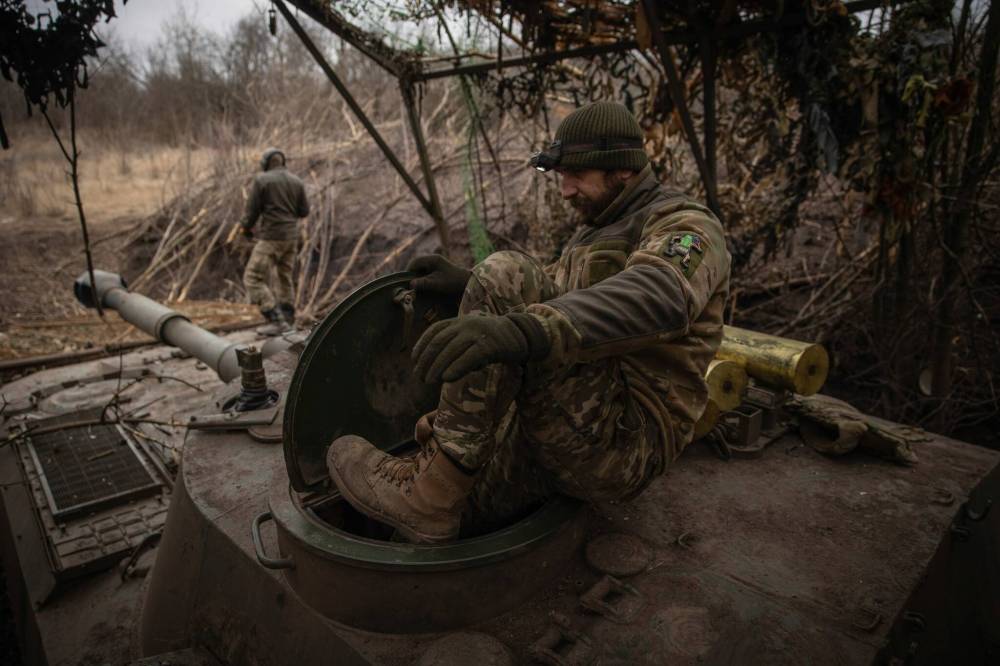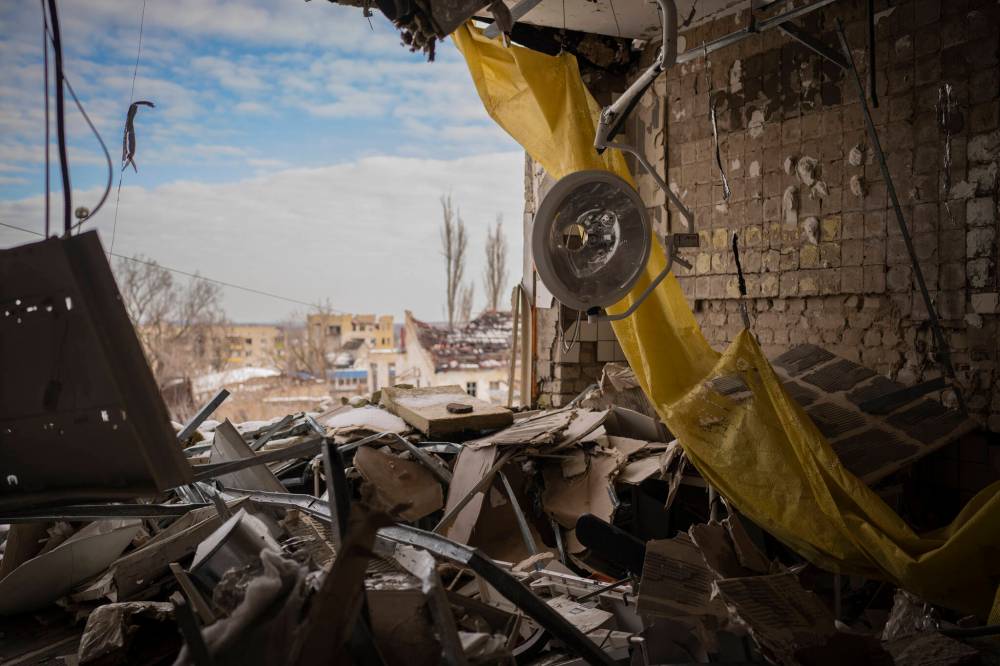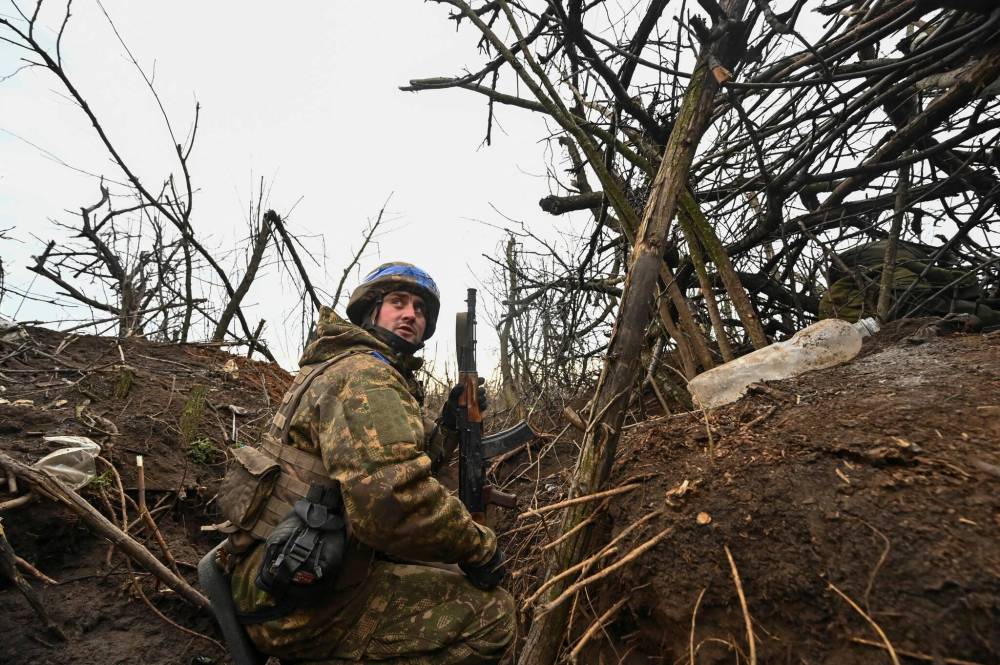Ground down by two years of war Dark milestone comes amid battlefield stalemates and waning international attention
Read this article for free:
or
Already have an account? Log in here »
To continue reading, please subscribe:
Monthly Digital Subscription
$0 for the first 4 weeks*
- Enjoy unlimited reading on winnipegfreepress.com
- Read the E-Edition, our digital replica newspaper
- Access News Break, our award-winning app
- Play interactive puzzles
*No charge for 4 weeks then price increases to the regular rate of $19.00 plus GST every four weeks. Offer available to new and qualified returning subscribers only. Cancel any time.
Monthly Digital Subscription
$4.75/week*
- Enjoy unlimited reading on winnipegfreepress.com
- Read the E-Edition, our digital replica newspaper
- Access News Break, our award-winning app
- Play interactive puzzles
*Billed as $19 plus GST every four weeks. Cancel any time.
To continue reading, please subscribe:
Add Free Press access to your Brandon Sun subscription for only an additional
$1 for the first 4 weeks*
*Your next subscription payment will increase by $1.00 and you will be charged $16.99 plus GST for four weeks. After four weeks, your payment will increase to $23.99 plus GST every four weeks.
Read unlimited articles for free today:
or
Already have an account? Log in here »
Hey there, time traveller!
This article was published 23/02/2024 (643 days ago), so information in it may no longer be current.
KYIV — After the third shot of vodka, and before calling up his favourite French pop music on his phone, Anatolich recalls the day Russia launched its full-scale invasion of Ukraine. He was driving a tour bus in Germany on Feb. 24, 2022; by the end of the week, he was standing at an enlistment office in Kyiv, hungry to join the fight.
It wasn’t a difficult decision, he says. For one thing, there was the fact his son had decided to serve; Anatolich didn’t think it was right if the son fought for Ukraine, while the father did not. But there was also this: at a time when many global observers were cynical Ukraine would be able to withstand the onslaught, Anatolich believed they could win.
He still believes, even now. Even as Ukraine trudges into Saturday’s grim second anniversary of all-out war, even as the country reckons with all it has lost, and all it will still have to lose before it has peace, the soldier from the working-class central city of Kryvih Rih still believes.

“We’re going to win,” Anatolich says, speaking in Russian on a recent night in Kyiv, during a break from his front-line unit. “We have no other choice. Even if we die, Ukraine will remain.”
The bravado suits him. Anatolich — his patronymic and, in the Ukrainian style, the name by which junior friends and colleagues call him — is a stout bear of a man, with close-cropped grey hair and a wide, jovial face. At 55, he’s not the youngest man on the front lines, but not unusually old either; many of those serving in the trenches are middle-aged men, like him.
He did not always serve at the front. For the first 14 months of the war, Anatolich worked in a recruitment office in Kyiv. But in late spring of 2023, as Ukraine battled to hold the lines in the killing fields of the east, he was abruptly transferred to an infantry assault unit near one of the war’s hottest positions.
In the months that followed, he threw his heart into the battle. He was injured, but recovered. Although he speaks little English, his gregarious charisma gave him a knack for whipping up support from foreign donors; he managed to obtain several vehicles from British supporters. He learned how to survive and, as a sergeant, tried to teach the same to his men.
There was reason to hope. The first year of resistance had revealed a remarkable resilience, both in the civilian and military spheres
But he lost many of those friends — too many. And though the experience has not dimmed his belief in victory, it has left him frustrated with the government and military leadership that, he thinks, has been too public with its war plans, too slow to replenish depleted units with fresh soldiers, or even too hesitant to set an example by sending their own kids to serve.
“The Ukrainian nation has shown already that they have not only the motivation, but are also determined to protect the country,” he says. “What the government needs to do is just do the same.”
He is far from alone in these frustrations. As Ukraine enters the third year of all-out war, the mood in the country is, in some ways, worse than at the beginning of the second. One year ago, Ukraine shivered in the cold. It was a mild winter, but months of Russian attacks on the country’s electricity grid had brought the system to its knees; portable generators lined city streets, their hum become Ukraine’s new winter music.
Yet there was a sense, in late February 2023, that if Ukraine could just endure until spring, if it could hang on until the ground thawed and the sun brought warmth, then it could get on with the business of repelling the invasion and clawing back its territory. At that time, many around Ukraine were sure the second year would bring them at least close to victory.
There was reason to hope. The first year of resistance had revealed a remarkable resilience, both in the civilian and military spheres. The country had largely banded together; motivated recruits like Anatolich had flooded enlistment offices; every problem the war presented, Ukrainians seemed to find a creative solution to adapt.
And on the battlefield, after Ukraine successfully repelled the attack on Kyiv in spring 2022, the next months saw the sudden collapse of Russian positions in the Kharkiv region and, closer to the end of that year, the liberation of Kherson. The military was preparing new units, trained by NATO countries and equipped with top-billed western armour and weapons, ready for a major push to reclaim occupied territory.

But the second year did little to pay off that hope. A widely feared repeat winter campaign to bring down the electricity grid never materialized; neither did progress in the summer counter-offensive, which failed to make a big breakthrough. And in Kherson, whose return to Ukrainian control brought so much hope in late 2022, liberation has meant a nightmare of daily shelling.
Meanwhile, the freelance foreign journalists started coming back to Ukraine in the last weeks of January, trickling into the capital, and war-ravaged parts south and east, after spending most of the winter away. It was not that they lacked care for the country, or its people. It was just, several told me, that by the fall of 2023, it was difficult to find buyers for their stories.
It wasn’t like that in the beginning. It was Europe’s largest land war in generations, and every aspect of its impact on people, culture and geopolitics was covered; even a fashion magazine ran a story about Ukrainian designers creating during war.
But news, by definition, prioritizes the new, and audiences, perhaps understandably, respond most to news that has the most chance of touching them personally. So as the conflict’s front lines stabilized into a long, grinding war of attrition, once it became clear a third world war was not immediately imminent, media interest in Ukraine ebbed.
And after Oct. 7, when the Israel-Hamas war exploded with a sudden spasm of catastrophic violence, global focus turned to the new nightmare, the new geopolitical flashpoint, the new humanitarian crisis. By late 2023, on some social media platforms, it was not uncommon to meet other users surprised to learn the war in Ukraine was still going on.
Living in Kyiv, one of the common questions I get from locals, after introducing myself as a journalist, is glum.
“Tell me,” they often say. “Is anyone in Canada still interested in Ukraine?”
It’s a question asked knowing the unity, both at home and abroad, that characterized the first year of international response to the invasion has started to crumble. Polish farmers are blockading the border over concerns about cheap Ukrainian grain traversing the country; American Republicans kiboshed a key support deal; and domestic politics in Ukraine has started to show more fractures.
All of those things play out over a foundation of deep and daily human trauma. Someone asked me once, not long ago, if the war was really “as bad” as “the media” says. What I can say, after living in Ukraine for a year and speaking with many soldiers and civilians working near the front, is that it’s actually much worse than most news articles can adequately capture — and most of that trauma is borne by the soldiers fighting on the front lines.
Neither side confirms its casualty figures, but what is certain is that the costs to life and health are staggering. Soldiers returning from the front tell horrific stories; others cannot speak about what they have seen, but simply cry. Many of the hundreds of thousands who rushed to serve in 2022 are now exhausted, traumatized and desperate for some sort of relief; most have not had a real break from fighting since the beginning of the invasion.

Mostly, it’s that there are not enough soldiers to replace them. If there is one thing on which all can agree, it’s that if Ukraine’s resistance is to continue, it needs more, of everything. More funding, more weapons — especially artillery shells, which are constantly in short supply — and, above all, more people.
To that end, Ukrainian lawmakers are preparing a new mobilization law that would expand eligibility for the draft, dropping the lower age limit to 25 from the current 27 and removing certain restrictions. But the move is politically fraught, and also puts Ukrainian leaders in a difficult spot.
Since the beginning of the full-scale invasion, Ukrainian leaders have stuck to putting on a strong face; acknowledging costly mistakes in the defence of the country, and the massive challenges it now faces in continuing that defence, is to admit a much less inspiring picture.
Yet it’s time to have that reckoning right out in the open, many living and fighting here say.
“The Ukrainian government, especially under Zelenskyy, is really, really hard trying (to say) ‘everything is cool, everything is normal, we will f——-g win this war,’” one soldier with the International Legion, who has fought in Ukraine since March 2022, told me. “In the first year, it was a good idea, definitely, it was critical. But now, it’s the wrong message.”
And when I ask Anatolich what he thinks will happen, whether his experience on the front lines has changed his faith in the outcome, his assessment is simple: not one of an analyst, but of a tour bus driver who became a soldier, because it’s his home.
“We will fight to the end,” he says, without hesitation. “Because we have to.”
There is no doubting the will of those who fight. Now, as Ukraine seeks to correct course in the third year of the invasion, with the fate of the nation and millions of people poised on the edge, the question Ukraine’s leaders and allies must answer is whether they can find the resources to support them.
Melissa Martin is the Free Press’s writer-at-large. She’s currently on leave, living in Ukraine.

Melissa Martin
Reporter-at-large
Melissa Martin reports and opines for the Winnipeg Free Press.
Every piece of reporting Melissa produces is reviewed by an editing team before it is posted online or published in print — part of the Free Press‘s tradition, since 1872, of producing reliable independent journalism. Read more about Free Press’s history and mandate, and learn how our newsroom operates.
Our newsroom depends on a growing audience of readers to power our journalism. If you are not a paid reader, please consider becoming a subscriber.
Our newsroom depends on its audience of readers to power our journalism. Thank you for your support.









